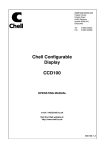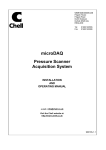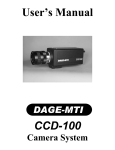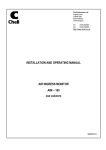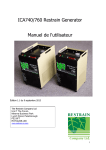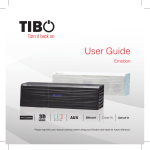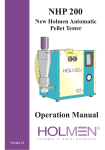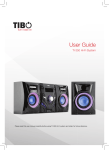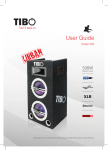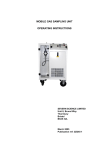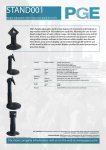Download the ILITS-3 user manual
Transcript
Chell Instruments Ltd Folgate House Folgate Road North Walsham Norfolk ENGLAND NR28 0AJ +44 1692 500555 ILITS-3 Impulse Line Integrity Test Set INSTALLATION AND OPERATING MANUAL e-mail:- [email protected] Visit the Chell website at: http://www.chell.co.uk 900107-1.1 Please read this manual carefully before using the instrument. Use of this equipment in a manner not specified in this manual may impair the user’s protection. INDEX Section 1 Section 2 Section 3 Section 4 Section 5 General Description Specification Installation and Interconnections Operation Service and Calibration Chell Document No. : 900107 Issue 1.1 ECO No. 0537 Date: 17th Sep 2008 Chell’s policy of continuously updating and improving products means that this manual may contain minor differences in specification, components and circuit design from the actual instrument supplied. Page 1 Section 1 General Description The Impulse Line Integrity Test Set, ILITS-3, is manufactured to allow testing of the reactor gas pressure measurement impulse lines. Testing is done by injecting a constant known gas flow though a line and measuring the pressure head required to maintain this flow. The test set comprises an adjustable regulator on the rear panel to set the input pressure to the internal mass flow controller. The output of the mass flow controller is used to pass gas into the line to be tested. This output port pressure is monitored by an internal capacitance manometer, measuring gauge pressure. Both pressure head and mass flow are clearly displayed on the bright front panel displays. The test set is fitted with an adjustable carry handle / desk stand to allow a degree of portability. Page 2 Section 2 2.0 Specification 2.1 Mechanical: 2.2 Package: Size (enclosure): Free standing desktop case, with prop-stand / handle H 220mm, W 360mm, D 490 mm depth (exc. adapters) Mounting: Weight: Free standing 14 Kg Power Supply: Line voltage: Line frequency: Consumption: Protection: 2.3 240V AC or 120V AC. (Factory Set) 50 ~ 60 Hz. less than 60 VA 1.6A anti surge fuse 20x5mm Operating conditions: Operating temperature range: Storage temperature range: Maximum Relative humidity: Warm up time to full accuracy: 2.4 +5°C to +50°C (40°F to 122°F) -20°C to +70°C (-40°F to 158°F) 95% at 50°C (non condensing) 30 minutes (assumes unit already stabilised at ambient). Pneumatic Interface: 3-7 bar(g) Supply Pressure: Type: Clean, Dry preferred, but the unit is fitted with an external filter / regulator. Fitting: Push-in type fitting to accept 12mm OD plastic tube. (Ensure that the tube used is compatible with this SMC Pneumatics fitting) Outlet: Flow: Flow range: Pressure: Pressure range: WARNING Controlled air flow, Measured at 1% FS error. 150 slpm Measured at 0.3% reading error 1000mb (g) Damage may result if the pressure transducer is exposed to pressure exceeding 1600 mb (g) Page 3 Section 3 3.0 Installation and Interconnections The instrument should operate free-standing on a flat level surface, such as a bench top. Note that the instrument must always be located in such a way as to enable adequate air circulation about the unit. fig. 1 - Rear Panel Services required by the test set are: Mains Power: 110-120 VAC 50-60 Hz. An IEC 320 type socket lead is required to connect. The mains voltage is factory set and a user should not attempt modification. Please consult Chell Instruments Ltd if you require the voltage setting to be changed. Air Supply: 12mm OD plastic tubing. Polyurethane or nylon is recommended. Metal tubing or adapters are not suitable, unless it is specifically designed for use with the SMC range of push-fit connections. The unit should be powered for at least 30 minutes before use to obtain full accuracy. Never place an obstruction or blanking plug in the outlet fitting of the test set. This may result in equipment damage or personal injury. Page 4 The user can gain access to an analogue retransmission of the displayed values via the interface connector. Interface socket Pin-out - 9 Way 'D' Type Caution Pin Number 1 2 3 4 Designation + Flow Signal - Flow Signal + Pressure Signal - Pressure Signal All other pins Not Connected Check the Mains Supply is correct and suitable before connection. This equipment must be properly earthed. Do not use this equipment if it is, or is suspected to be, wet or near water, faulty or partially assembled. Failure to follow advise given in this manual and/or on the product may result in equipment damage, personal injury or death. Page 5 Section 4 4.0 Operation of the instrument Before switching on the power, ensure that the correct mains supply voltage is connected. After power on, the display will light. The actual value displayed will depend on the output of the transducer. In an overrange condition the display flashes. It is recommended that gas supply and test product not be connected until the test set is ready for use. Allow 30 minutes warm-up before using for accurate measurement and control. Warning If there is a probability that the load to be tested is completely blocked or blanked, the flow rate must be set to a low value initially, with the regulator set to no more than 1.5 bar. Failure to follow this procedure may result in permanent damage to the pressure sensor. Once the status of the load has been ascertained normal settings can be applied. 4.1 Front Panel Controls. More detailed information may be found in the accompanying CCD100 user manual. fig. 2 - Front Panel 4.1.1 Zero Trim Before the test set is used, and after the 30 minute warm-up time has been observed, the displays should be ‘zeroed’. To do this ensure that the gas supply is disconnected, or the regulator is set to minimum, Page 6 and there is no product connected to the output of the test set. Press the zero button on each display and hold for 3 seconds. Any offset on the display will be removed. 4.1.2 Flow Command (Setpoint) The flow control may be adjusted but changing the flow setpoint. This is achieved by pressing the up or down arrows as appropriate. The display will show the setpoint and the actual flow on a two-line display. The Flow mode can be changed between Open, Closed, and Auto by using the override key: Auto: Press Overide, then Auto (it’s the same key ) Close: Press Overide then Close. Note the display now shows ‘CLOSE’ Open: Press Overide the Open. Note the display shows ‘OPEN’ It is usual that the flow controller may take a few moments to commence control. 4.2 Rear Panel Controls (see fig.1 pg 4) 4.2.1 Power Switch The mains switch is located next to the mains inlet cord. 0 = off 1 = on 4.2.2 Fuse This is located next to the mains cord socket. The mains cord must be removed in order to withdraw the fuse compartment. Do Not attempt to open the fuse compartment with the mains cord attached. Always replace the fuse with the correct type and rating. 4.2.3 Regulator The inlet pressure regulator is located at the rear of the unit. To adjust this regulator, turn the knob clockwise to increase the pressure and anti-clockwise to reduce the pressure. Observe the dial gauge on the rear panel to check the inlet pressure. If the knob fails to move easily it may be locked, pull the knob upward to unlock, press downward to lock. It is recommended that a pressure of 1.5 bar is set for full scale flow. A pressure of this value will help to protect the internal pressure transducer from damage. Page 7 Section 5 Service and Calibration 5.1 Service There are no user serviceable parts inside the instruments. Should any difficulties be encountered in the use of the test set, it is recommended that you contact Chell Instruments Ltd for advice and instructions. 5.2 Calibration Calibration is recommended on an annual basis and Chell Instruments Ltd. Provides a fully traceable facility for this purpose. 5.3 Adjustment There are no user adjustments in the instrument, indeed, the presence of lethal voltages within the instrument means that the user is strictly forbidden from removing the covers without invalidating Chell’s obligations under both Warranty and COSSH. 5.4 Cleaning A dirty instrument may be wiped clean with a soft cloth that has been sprayed with a proprietary ‘foaming cleaner’, then wiped dry immediately. Under no circumstances should the instrument be wetted directly or left damp. Page 8









